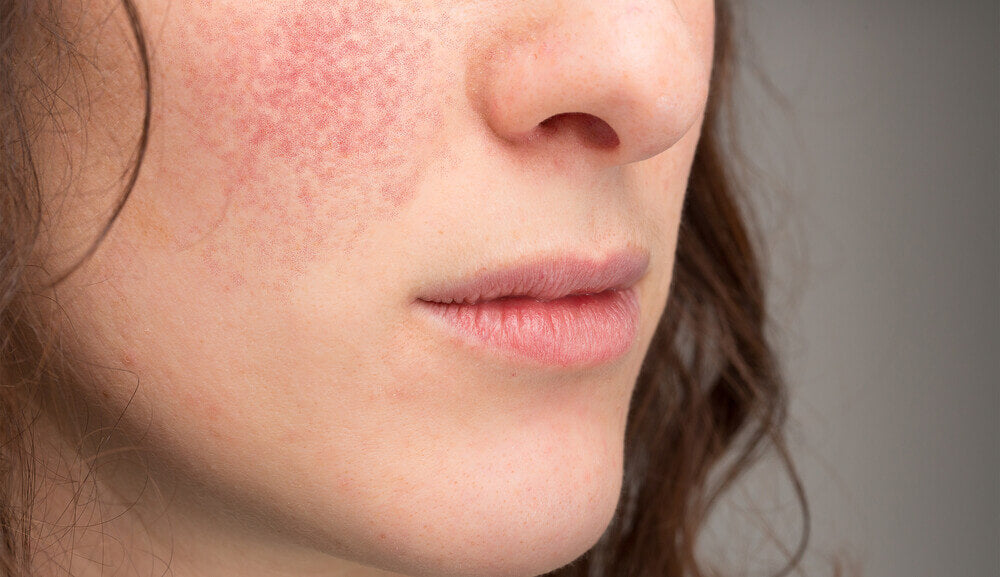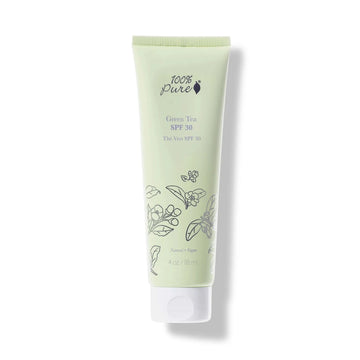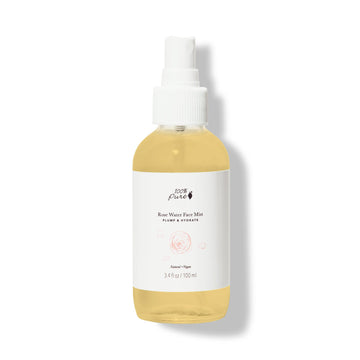Symptoms, causes, and how to soothe blotchy skin
Written by: 100% PURE ®
Blushing after cardio or being put on the spot in a group setting is one thing, but persistent skin redness and blotchiness can be frustrating. Adding to the madness is the attempt to figure out if your redness is from skin sensitivity or something lifestyle related, like dietary choices.
While neither skin condition is ideal, experiencing constant facial redness is going to require more than just the ice cube trick. We’ll give you the 411 on skin redness, and tips on what to do to calm your complexion.
Most of the time, a flushed complexion is a sign of health and vitality. Think about that soft, pink glow that hits your cheeks after a walk or a good belly laugh. Though we love a good glow, what causes skin to turn red in the first place?
Flushing happens whenever there is more blood flow to an area of skin, and the blood vessels dilate or widen to compensate. When these blood vessels expand, they rapidly fill with more blood, which can make the skin appear red or pink or ‘flushed’.
Flushed skin is a common response to anxiety, stress, embarrassment, anger, or being too hot. Facial flushing is usually more of a social worry than a medical concern. However, frequent flushing can sometimes indicate hormonal changes, poor dietary choices, or underlying medical conditions.
Seeing red? Skin flushing or blushing describes feelings of warmth and temporary reddening usually of the face. But rosy Santa cheeks or a non-sun-kissed look aren’t just limited to the face. In some people the ears, neck, and chest also blush. Blotchiness or solid patches of redness are often visible when blushing.
Though it’s most likely a normal response, nobody wants to look like a tomato – especially if the color doesn’t to go away. The good news is you can alleviate some of the red-face-factor with a few lifestyle adjustments. Pay attention to what you put in your body to keep internal temperatures cool, and what you put on your body to decrease risk of irritation. It's all about balance!
When life gets hectic, it’s easy to get a little lax with your skin care routine. But this can affect the skin’s outer layer, leaving it vulnerable to irritants, redness, and blotchy skin. Here are some tips on giving your skin much-needed relief to bring back your skin back to its happy place.
#1. Follow a regular SPF routine
Sun exposure can alter the appearance of blood vessels under your skin on your face, creating an overall reddish color. Always use a broad-spectrum SPF and be sure to reapply it every few hours, particularly after swimming, sweating, or rubbing.
#2. Patch test for irritating ingredients
If you're trying a new product in the future – whether it be skin care, makeup, body care or hair care – patch test before use. Place a small amount on the inside of your elbow and wait 48 hours to 72 hours. If you have redness, swelling, itching, or burning, don't use that product.
#3. Determine if it's related to hormonal changes
Hormonal changes that occur during your monthly cycle or perimenopause – the loss of estrogen – can increase flushing. Skin redness will usually clear up after your period starts, while persistent redness might need to be evaluated by a medical professional.
#4. See if diet plays a role in redness
Summer months have us feeling hot, hot, hot – so it’s not a great time to cover everything in hot sauce. If you have skin redness, you might want to eat the following items sparingly: hot sauce, chocolate, cheese, tomato, avocado, red plums, walnuts, and eggplant. This doesn't mean you can't eat them, just pay attention to what happens when you do, and adjust your diet accordingly.
#5. Try anti-inflammatory foods
Avoid trigger foods like caffeine and spicy items and try adding more face-friendly choices to help calm skin redness. Anti-inflammatory foods like carrots, sweet potatoes, and broccoli are packed with antioxidants that will help to hydrate and fortify skin cells.
#6. Use soothing ingredients
Products containing niacinamide, sulfur, allantoin, caffeine, licorice root, chamomile, aloe and cucumber can help reduce redness. The more natural the ingredients, the better at calming a red complexion.
PRO TIP: Our Caffeine Mask is made out of cooling aloe gel biocellulose and infused with 3 sources of anti-inflammatory caffeine: yerba mate, coffee, and green tea.
#7. Cool down the skin
Just because a label says something is "hypoallergenic", "dermatologist tested", or "non-irritating", that doesn't mean the product will get along with your skin. Tried and true ingredients for calming skin are rose, aloe, cucumber, and topical analgesics like peppermint.
PRO TIP: For calming and cooling in a pinch, try a Rose Water Face Mist.
#8. Pair down your routine
Identify and remove the products that are causing skin redness or blotchiness. Focus on swapping them out for gentle alternatives that will make blotchy skin a thing of the past.
#9. Underlying conditions
Talk to a doctor or dermatologist if skin redness or blotchy skin is happening often or with more than one product, or the symptoms continue after discontinuing use of the product.
#10. Know your triggers
In addition to the aforementioned facial redness triggers, those prone to rosacea and eczema can also experience aggravated skin after taking a hot shower, drinking alcohol, exercising and using products with fragrance (synthetic or natural).
#11. Take notes
Work to identify the ingredients causing an anti-inflammatory or persistent reaction. Introduce one product at a time and allow adequate time for any potential reaction before moving on to the next one. Keep a list!
We carefully hand-select products based on strict purity standards, and only recommend products we feel meet this criteria. 100% PURE™ may earn a small commission for products purchased through affiliate links.
The information in this article is for educational use, and not intended to substitute professional medical advice, diagnosis, or treatment and should not be used as such.



